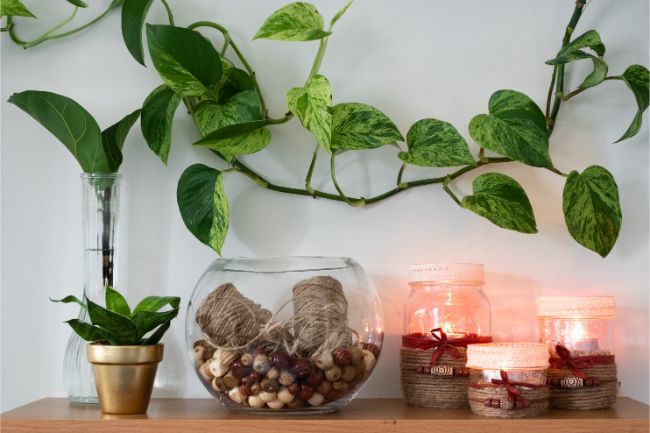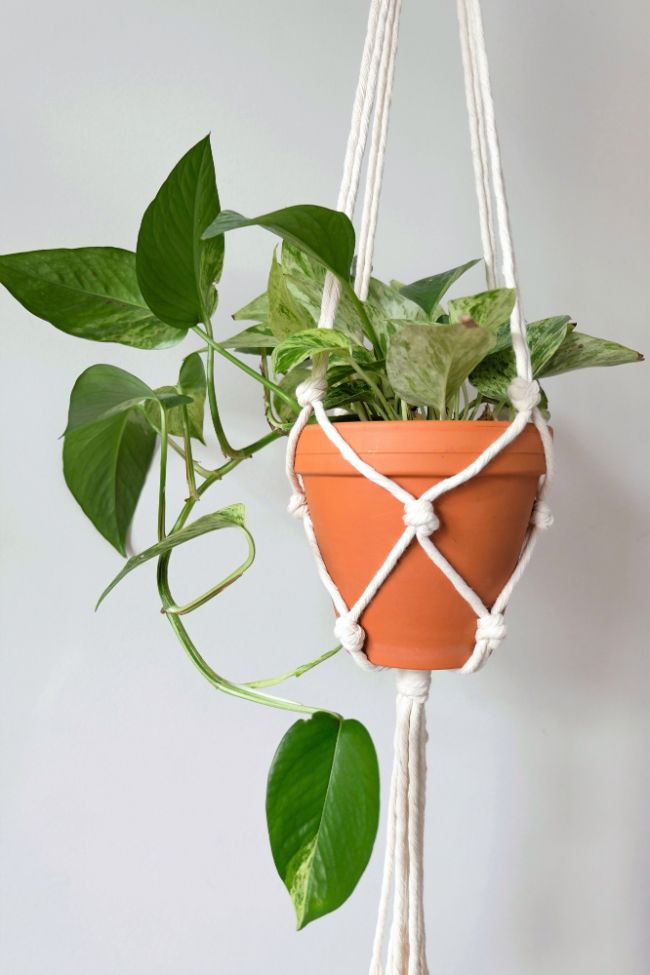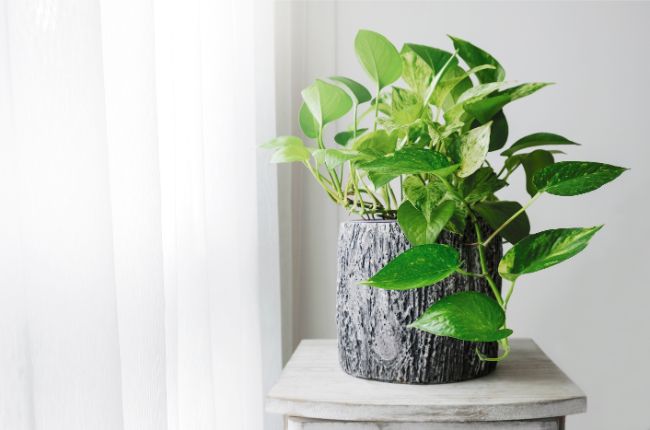Pothos are a really popular houseplant and notorious for being fairly indestructable. But as with any plant in your home, particularly one with a common name like Devil’s Ivy, you might wonder are pothos poisonous?
Are Pothos poisonous? Yes, Pothos plants are poisonous if ingested and can be irritant to the skin if touched. They are not known to be fatal, but they will cause irritation to your lips and tongue, and they can make you vomit. Make sure to keep the plant away from cats, dogs, and children.
Having said this, if you handle the plant properly and keep it away from kids and pets, this is one of the easiest plants to take care of, no matter how poorly you deal with it. The plant has been known to survive periods of drought as well as darkness. Read on as I explain why Pothos are poisonous and how to care for them safely.
Why Are Pothos Poisonous?
The thing that makes Pothos plants poisonous is the insoluble calcium oxalate crystals contained within their leaves and stems. These crystals resemble small glass shards that will physically pierce and cause localized irritation to the skin when touched, or the mouth and digestive tract when chewed or swallowed.
In very rare cases, ingestion of part of a Pothos plant can also cause swelling of the upper airway, making it difficult to breathe.
All parts of this plant are toxic if ingested, so be very careful and make sure to keep it away from pets and children.
In case of accidental ingestion, you can immediately call the Poison Center at 1-800-222-1222. They will provide assistance.
How To Grow Pothos Plant Safely?
Knowing about the toxicity of Pothos plants is the most important thing to allow you to grow this plant safely. You should ensure that your Pothos is grown out of reach of children and pets.
You will probably have a good idea how your pets and children react to your indoor plants. Some kids and pets can’t seem to leave indoor plants alone, while others wouldn’t notice an indoor jungle.
Obviously, my home is full to bursting with houseplants, and I have two young children that merrily ignore them. I’m lucky if my daughter makes a passing comment about some pretty pink flowers on one of my plants. Luckily, I haven’t caught either of my children eating my plants, yet!
I take a fairly cautious approach to growing my houseplants, ensuring that any plants that are known to be toxic are either kept out of reach or in a room that my children cannot access.
Of course, if you are particularly concerned about the risk of growing a Pothos plant, then there are many beautiful alternative foliage plants that are non-toxic. Examples include Pinstripe Calathea, Prayer plant, Wandering Jew Plant and Peperomias.
See this article for more houseplant options that are safe for pets.
Placement
As mentioned above, If you have pets and children, where you place these plants will be important. This plant is highly toxic if ingested, and pets and children are notorious for eating things they aren’t supposed to, so making sure that they are placed in higher locations is key.
Another reason for placing these plants on a higher point is so that you can properly showcase the growing vines for their full effect. Great places to keep these plants are on top of bookshelves, hung from the ceiling, or even on a high plant stand.
If you think that the vines are getting too long, a great tip is to hang the vines from strategically placed hooks. These will still keep them at a higher location and away from curious hands.

Pothos Care
Pothos plants are one of the easiest plants to grow. They require very little attention for them to grow and even thrive. In the United States, these plants are mostly grown indoors, except for USDA hardiness zones 10 and 11. In these areas, the plant can survive outdoors.
For this post, we will talk about how to grow them safely indoors. Just follow a few basic steps, and you’ll have yourself a thriving Pothos.
Before I discuss general care, there are a few common problems with Pothos plants that I have covered in other articles that you might like to read.
- How to grow Pothos Faster (Get lush trailing vines in double quick time).
- Why do Pothos plants get curled leaves.
- Why do Pothos plants get yellow leaves, and how to fix this.
Length
Pothos plants typically grow anywhere from six to 10 feet long, and sometimes the vines can grow as long as 30 feet.
Of course, you can always prune and propagate the plant to keep it at a certain length. The choice is yours, and it all depends on how you want to display the plant in your space.
Light
Pothos can grow in varying lights. It flourishes in medium indirect light. However, this amazing plant can also survive in very low light conditions.
Hence, you will find this plant to be popular in office spaces. The different light levels within an office space will not significantly affect the growth of this plant, although Pothos kept in very low light will grow more slowly and the foliage will be less lush and vibrant.
There are signs you can look out for to make sure you’re not losing your plant due to incorrect lighting. These are:
- Many Pothos varieties have yellow or white marbled leaves. If you start to see the variegation of the leaves disappearing, then that means that the plant is not getting enough light. And it’s time to get some indirect sunlight on it.
- If you start to see your leaves turning more yellow or white, instead of having a balanced marble color, then that means your plant is getting too much light, and maybe it is time to change the location of your plant to a less bright location.
Water
Once again, the magic of this plant is that it doesn’t require a lot of water. It can go weeks without water. In fact, Pothos do best if their soil is given time to dry out a little between watering. So, don’t panic if you have forgotten to water the plant once or twice. It will still survive.
Like with the light, there are ways you can know if the plant is thirsty or if you’re drowning it. Obviously, if your plant is nice and green and lush and overall looking healthy and happy, then you’re golden and have nothing to worry about. Otherwise be on the lookout for:
- If your plant is wilting, losing its glossiness, turning brown at the tips of the leaves or if the vines just look limp, then that means you are not watering it enough. Your best bet at revival is to quench the poor plant’s thirst. Give it a good dousing of water and let it be. You’ll see it start to come back to life in a few days.
- If the leaves on your plant are turning yellow, you may well be overwatering your plant. Slowly remove it from the pot and check to see if the roots are standing in water. Excess water can cause the roots to rot, which should be identified and treated immediately if you want to save your plant.
If you really want to become a pro at telling exactly when your houseplants need water, read my articles about “how to tell when to water your indoor plants” and “how often to water indoor plants”.

Temperature
Pothos can survive in most temperatures, but they live their best lives in warm temperatures. Anywhere between 60-85 ºF (15-29 ºC) is their ideal temperature. They will also do best in moderate to high humidity conditions, but can tolerate lower humidity well.
Repotting
Once every year or two, it is a good idea to repot these plants. This helps give the roots room to grow, which helps with the overall growth of the plant. To repot, carefully lift the plant out of its current pot and carefully place it in new soil in the new pot.
Pruning
This will help with keeping the plant neat, clean, and manageable.
The best way to do this is to just get rid of any leaves that have fallen, cut any vines that have no leaves and even just trimming leaves that don’t look too good.
Propagating
You can cut a stem with several leaves and put it in water until it grows a root. Then transfer it to a pot with soil and let it grow.
Alternately, you can plant the stem with the roots in the same pot as you took the stem from, this can help your plant look fuller, once the stem starts growing.
Soil
Pothos plants aren’t picky when it comes to what they need to grow. A little water, a little light, and little soil and they’re good to go.
So, it doesn’t need anything fancy. Just a regular well-draining soil will do.
Fertilizer
Same as the soil, Pothos don’t need anything special for them to grow but, you can give it a balanced houseplant fertilizer once or twice a year. I’ve been using this houseplant fertilizer for the last few years, and I’ve seen fantastic results.
In Conclusion
Pothos plants, even though toxic, are one of the most popular house or office plants for so many reasons. They look great, thrive in a range of conditions and don’t require a lot of maintenance if you keep up with them once every few weeks.

